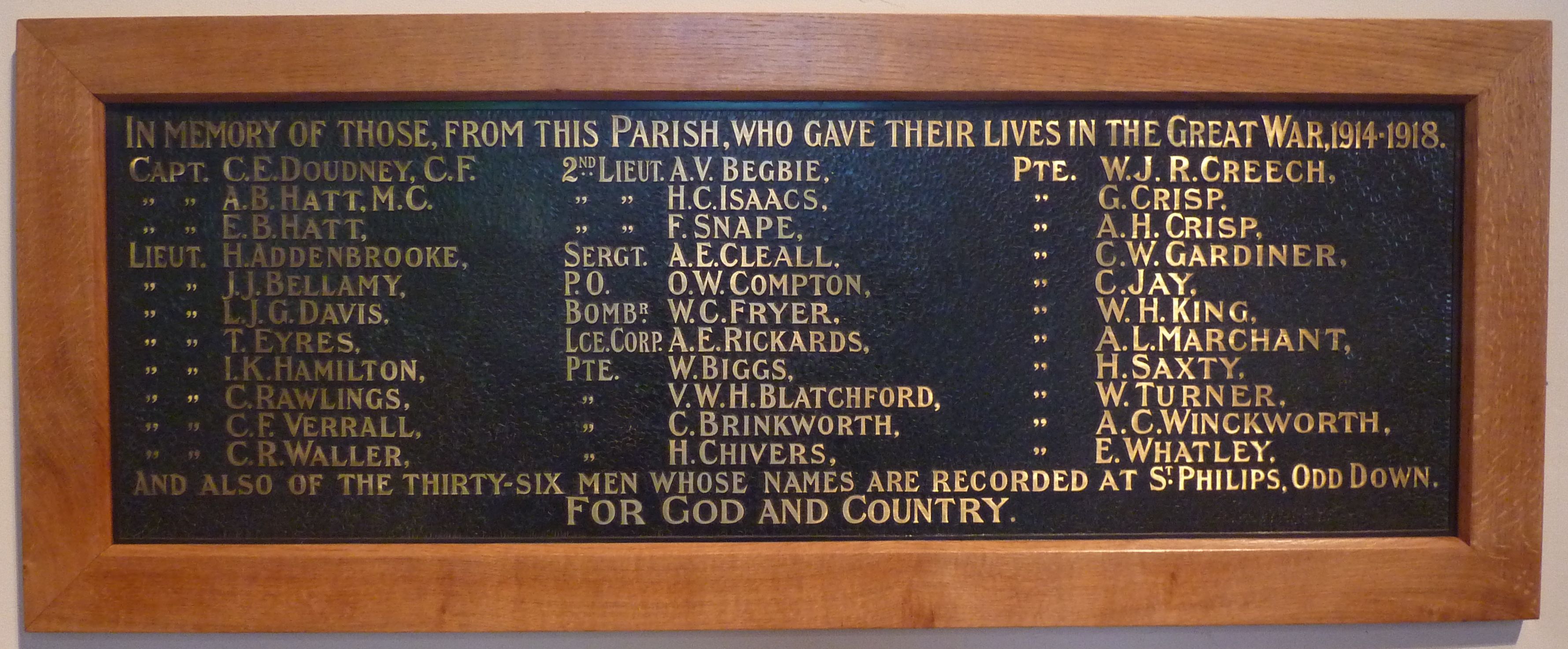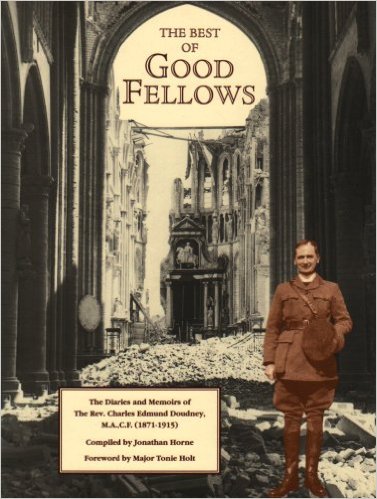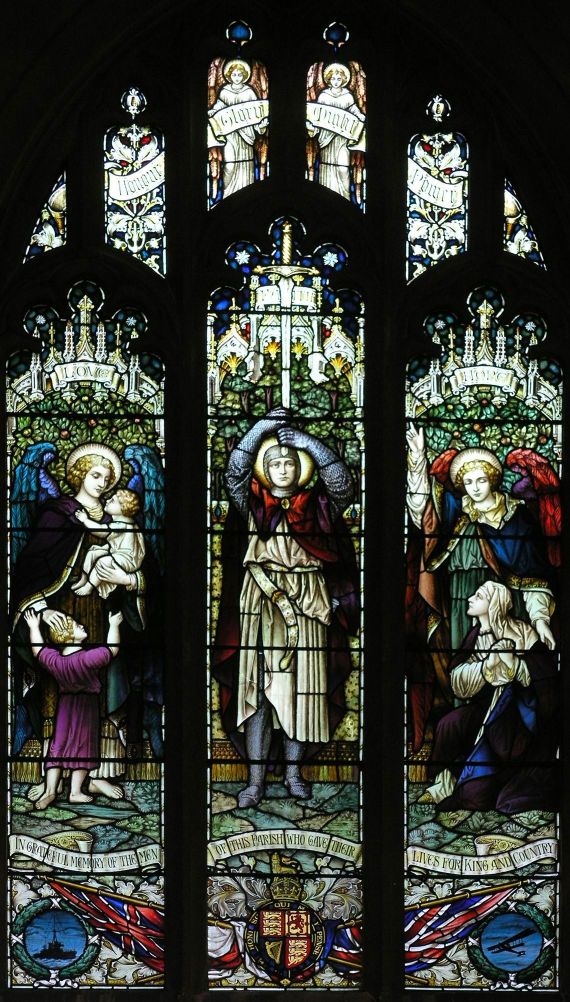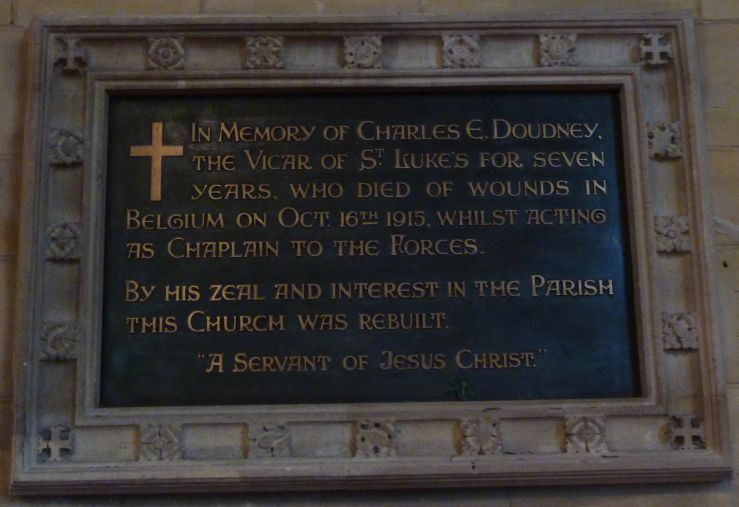Oldfield Park Junior School (Bath) WW1 Memorial Project
St Luke's (Bath) WW1 Memorial

This memorial tablet is in situ in the south aisle of St Luke's, in what used to be known as South Lyncombe, in the parish of Lyncombe & Widcombe.
The first name on this memorial is of the genial vicar of the church, Rev. Charles Doudney, who went to serve as a chaplain on the Western Front. His wonderful diaries and memoirs are compiled in the book "The Best of Good Fellows". A thoroughly recommended read. The book is often available on used book sites and online auctions.

The next two names are those of the Hatt brothers, sons of the one time Mayor of Bath (1915-16), Harry Hatt.
In February 1919 there was a suggestion that a church war memorial could take the form of a young men's institute, or that the church rebuilding work (started by Charles Doudney) could be completed as an act of remembrance. There was a popular Institute on Odd Down (next door to St Philip's church) at the time and the idea of having one further down the hill was a popular one. The idea was put forward of trying to buy an army hut, such as were being decommissioned in large numbers and which were therefore available cheaply. The church hierarchy believed that an Institute would not only serve exactly the section of the population (young men) who had served in the war, but that it might also form a pathway into the church for those men, whereas a stained glass window or a tablet might not perform the same function.
By June, however, it had been decided that a memorial window would be installed in the centre of the south aisle.
From Bath Chronicle & Weekly Gazette, 22nd November 1919:
ST. LUKE'S WAR MEMORIAL
Rector of Bath Dedicates a Stained Glass Window
Rector of Bath Dedicates a Stained Glass Window
On
Sunday afternoon, Preb. S. A. Boyd (Rector of Bath) unveiled and
dedicated the window which has been placed in the south transept of St
Luke's, South Lyncombe, in memory of those connected with the parish
who perished in the war. The Lord Bishop of the Diocese, who had hoped
to perform the ceremony was too unwell to officiate. There was a large congregation.
The congregation included Alderman Sir Harry Hatt, Lady Hatt, Miss Alice Hatt, and Miss Margaret Hatt.
The other robed clergy present were the Vicar of St. Luke's (the Rev. H. W. Doudney) and the Rev. G. W Trevor. In the procession were the churchwardens (Messrs. H. Harding and E. Brake), with their wands of office, and three lay readers — Mr. A. R. Saxty (in charge of St. Philip's, Odd Down), and Mr. S. L. Eversfield. Mr. Woodward (of Twerton) was also present.
The processional hymn, "O God, our Help in ages past", was followed by the first verse of the National Anthem. After the opening sentences from the Burial Office and some appropriate passages, the "Shepherd Psalm" was sung. The special lesson read by Sir Jenner Verrall, was taken from Wisdom iii., verses 1 to 9, and v., verses 15 to 17. The congregation stood while the Vicar read the names of those commemorated on the memorial tablet, and a short pause was then made for silent prayer and thanksgiving. Then, while the congregation remained kneeling, the choir sung Stainer's anthem "What are these?" The singing of the hymn " The Saints of God" was followed by suitable prayers, and the Rector of Bath then walked in procession with the choir, churchwardens, and the other clergy from the chancel to the south transept. The first three verses of the hymn, "Come, then Holy Spirit, come" were sung meanwhile. After the dedication cerenuny, the remaining two verses the hymn were sung as the choir returned to the chancel.
PREB. BOYD'S ADDRESS
In an address from the pulpit, the Rector of Bath said they had gathered that afternoon to fulfil the high and sacred purpose—the dedication of memorial to those who had freely given their lives for their King and country, and in the cause of righteousness. They had united to honour those to whom honour was due. This window was erected to commemorate those who did indeed act gloriously, and their unselfish sacrifice would be recorded in that church as long that window remained in its position. Might that window be an inspiration all who gazed on it to strive to exercise feelings of kindliness and brotherliness and make this world a better world.
During the singing of the hymn, "For all the Saints", a collection was made on behalf of the war memorial fund at St. Philip's, Odd Down.
After the Benediction, Bugler Roper, of the King's Royal Rifles, sounded the "Last Post", and as a Recessional, the "Nunc Dimittis" was sung.
THE MEMORIAL WINDOW
The window consists of three lights. The centre is occupied by a knight in armour, typical of Faith. The left side bears the design of an angel tending two children, signalising Love, and the corresponding design on the right side is another angel comforting a mourning woman, in token of "Hope". The small lights above contained scrolls bearing the words "Honour, Glory, Might, Power." At the bottom are placed the Royal Arms, flanked by the Union Jack. The design is completed by two small representations of a battleship and an aeroplane.
At the foot the window are the words: "In grateful memory of the men of this parish who gave their lives for King and Country.
Beneath the window is tablet bearing the inscription:
The congregation included Alderman Sir Harry Hatt, Lady Hatt, Miss Alice Hatt, and Miss Margaret Hatt.
The other robed clergy present were the Vicar of St. Luke's (the Rev. H. W. Doudney) and the Rev. G. W Trevor. In the procession were the churchwardens (Messrs. H. Harding and E. Brake), with their wands of office, and three lay readers — Mr. A. R. Saxty (in charge of St. Philip's, Odd Down), and Mr. S. L. Eversfield. Mr. Woodward (of Twerton) was also present.
The processional hymn, "O God, our Help in ages past", was followed by the first verse of the National Anthem. After the opening sentences from the Burial Office and some appropriate passages, the "Shepherd Psalm" was sung. The special lesson read by Sir Jenner Verrall, was taken from Wisdom iii., verses 1 to 9, and v., verses 15 to 17. The congregation stood while the Vicar read the names of those commemorated on the memorial tablet, and a short pause was then made for silent prayer and thanksgiving. Then, while the congregation remained kneeling, the choir sung Stainer's anthem "What are these?" The singing of the hymn " The Saints of God" was followed by suitable prayers, and the Rector of Bath then walked in procession with the choir, churchwardens, and the other clergy from the chancel to the south transept. The first three verses of the hymn, "Come, then Holy Spirit, come" were sung meanwhile. After the dedication cerenuny, the remaining two verses the hymn were sung as the choir returned to the chancel.
PREB. BOYD'S ADDRESS
In an address from the pulpit, the Rector of Bath said they had gathered that afternoon to fulfil the high and sacred purpose—the dedication of memorial to those who had freely given their lives for their King and country, and in the cause of righteousness. They had united to honour those to whom honour was due. This window was erected to commemorate those who did indeed act gloriously, and their unselfish sacrifice would be recorded in that church as long that window remained in its position. Might that window be an inspiration all who gazed on it to strive to exercise feelings of kindliness and brotherliness and make this world a better world.
During the singing of the hymn, "For all the Saints", a collection was made on behalf of the war memorial fund at St. Philip's, Odd Down.
After the Benediction, Bugler Roper, of the King's Royal Rifles, sounded the "Last Post", and as a Recessional, the "Nunc Dimittis" was sung.
THE MEMORIAL WINDOW
The window consists of three lights. The centre is occupied by a knight in armour, typical of Faith. The left side bears the design of an angel tending two children, signalising Love, and the corresponding design on the right side is another angel comforting a mourning woman, in token of "Hope". The small lights above contained scrolls bearing the words "Honour, Glory, Might, Power." At the bottom are placed the Royal Arms, flanked by the Union Jack. The design is completed by two small representations of a battleship and an aeroplane.
At the foot the window are the words: "In grateful memory of the men of this parish who gave their lives for King and Country.
Beneath the window is tablet bearing the inscription:
In memory of those, from this Parish, who gave their lives in the Great War, 1914-1918

